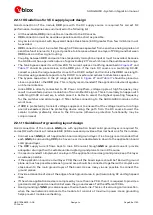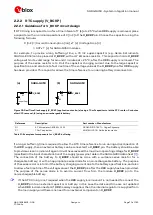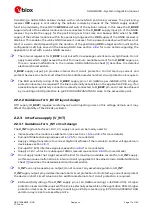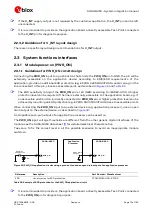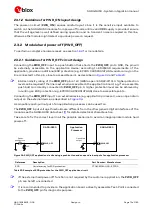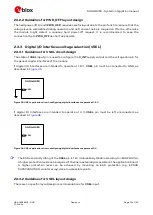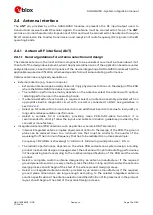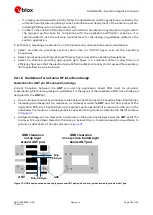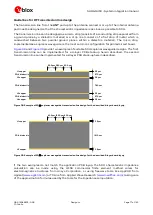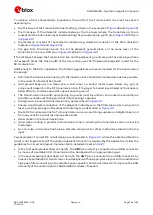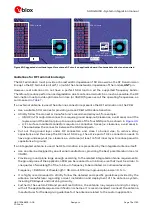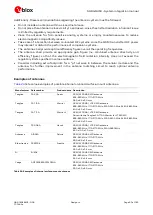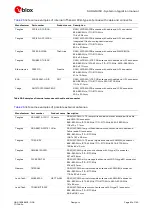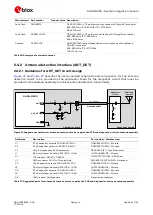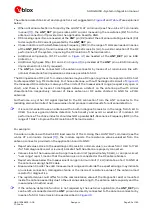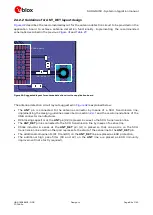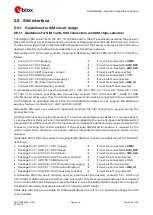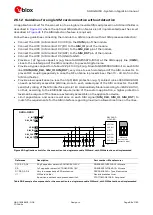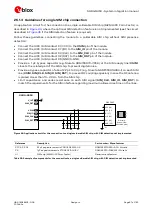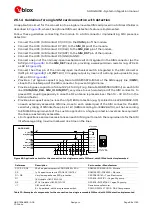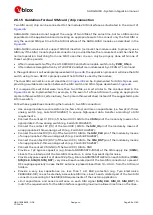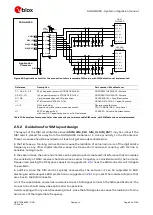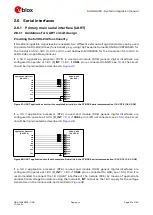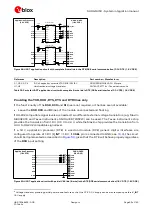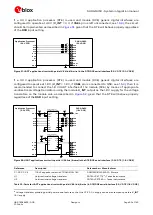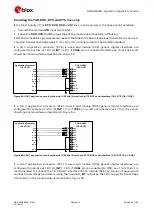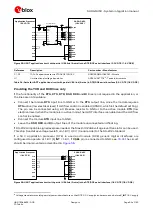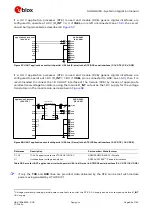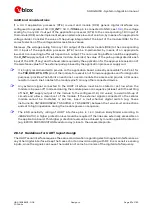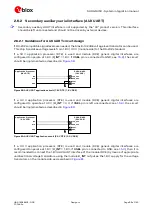
SARA-G450 - System integration manual
UBX-18046432 - R08
Design-in
Page 83 of 143
C1-Public
The antenna detection circuit and diagnostic circuit suggested in
are explained
below:
When antenna detection is forced by the +UANTR AT command (see the u-blox AT commands
manual
), the ANT_DET pin generates a DC current measuring the resistance (R2) from the
antenna connector (J1) provided on the application board to GND.
DC blocking capacitors are needed at the ANT pin (C2) and at the antenna radiating element (C4)
to decouple the DC current generated by the ANT_DET pin.
Choke inductors with a Self-Resonance Frequency (SRF) in the range of 1 GHz are needed in series
at the ANT_DET pin (L1) and in series at the diagnostic resistor (L3), to avoid a reduction of the RF
performance of the system, improving the RF isolation of the load resistor.
Additional components (R1, C1 and D1 in
) are needed at the ANT_DET pin as ESD
protection.
Additional high pass filter (C3 and L2 in
) is provided at the ANT pin as ESD immunity
improvement (not strictly required).
The ANT pin must be connected to the antenna connector by means of a transmission line with
nominal characteristics impedance as close as possible to 50
.
The DC impedance at RF port for some antennas may be a DC open (e.g. linear monopole) or a DC short
to reference GND (e.g. PIFA antenna). For those antennas, without the diagnostic circuit of
the measured DC resistance is always at the limits of the measurement range (respectively open or
short), and there is no means to distinguish between a defect on the antenna path with similar
characteristics (respectively: removal of linear antenna or RF cable shorted to GND for a PIFA
antenna).
Furthermore, any other DC signal injected to the RF connection from the ANT connector to the
radiating element will alter the measurement and produce invalid results for antenna detection.
☞
It is recommended to use an antenna with a built-in diagnostic resistor in the range from 5 k
to
30 k
to ensure good antenna detection functionality and avoid a reduction of module’s RF
performance. The choke inductor should exhibit a parallel Self-Resonance Frequency (SRF) in the
range of 1 GHz to improve the RF isolation of the load resistor.
For example:
Consider an antenna with built-in DC load resistor of 15 k
. Using the +UANTR AT command (see the
u-blox AT commands manual
), the module reports the resistance value evaluated from the
antenna connector provided on the application board to GND:
Reported values close to the used diagnostic resistor nominal value (i.e. values from 13 k
to 17 k
if a 15 k
diagnostic resistor is used) indicate that the antenna is properly connected.
Values close to the measurement range maximum limit (approximately 50 k
), or an open-circuit
“over range” report, means that the antenna is not connected or the RF cable is broken.
Reported values below the measurement range minimum limit (1 k
) indicate a short to GND at
the antenna or along the RF cable.
Measurement inside the valid measurement range and outside the expected range may indicate
an unclean connection, damaged antenna or the incorrect resistance value of the antenna load
resistor for diagnostics.
The reported value could differ from the real resistance value of the diagnostic resistor mounted
inside the antenna assembly due to the antenna cable length, the antenna cable capacity and the
measurement method used.
☞
If the antenna detection function is not required by the customer application, the ANT_DET pin
can be left unconnected and the ANT pin can be directly connected to the antenna connector by
means of a 50
transmission line as described in

